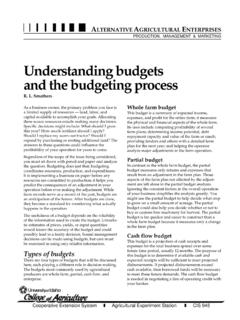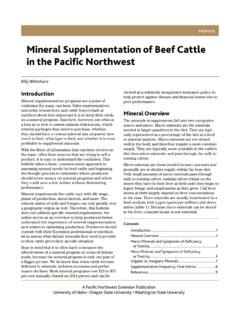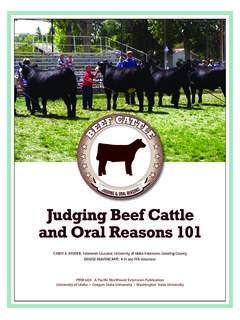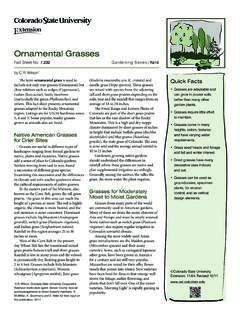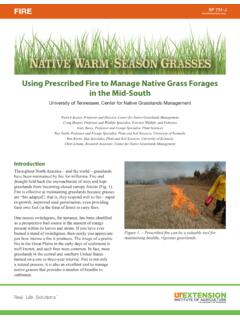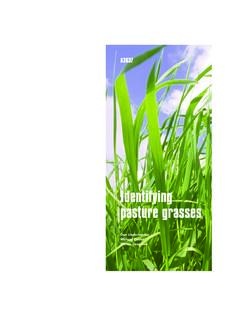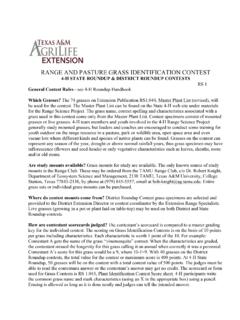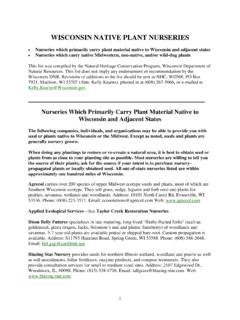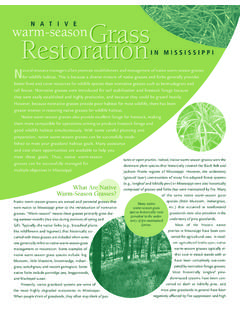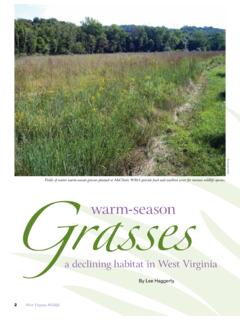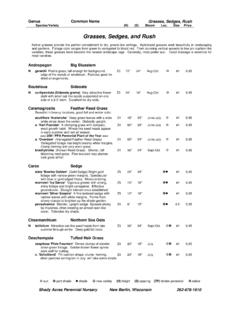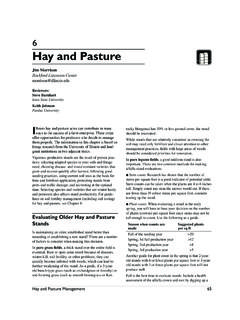Transcription of Ornamental Grasses for Idaho Landscapes
1 1 CIS 1161 Ornamental Grasses for IdahoLandscapesby Stephen L. Love and Thomas Salaizphotos by Stephen L. Love, University of IdahoUniversity of Idaho Extension Idaho Agricultural Experiment StationIntroductionOrnamental Grasses differ from other more commongrasses used in lawns or pastures only in being chosenfor their attractive form and color. They have been usedfrom ancient times to beautify Landscapes in old-worldplaces such as China and Japan. They are quicklybecoming irreplaceable landscape elements in manyparts of the United States. In Idaho , Ornamental grassesare just beginning to increase in popularity. Many beauti-ful Grasses are adapted to Idaho climates and soils, andthey have unlimited potential for enhancing Grasses vary widely in size, shape, confor-mation, and color. Some grow best in cool weather,others in hot. A few will grow in shade. Some spreadfrom rhizomes and will fill in large areas, while mostare clump-forming and stay confined.
2 There are xericgrasses that can grow in very dry conditions without irri-gation and moisture-tolerant Grasses that grow in boggyplaces. Some Ornamental Grasses have a stiff, uprightgrowth habit, while others virtually lie on the incredible diversity means Ornamental grassescan be used to create many effects in the can be used in places that are typically given toshrubs, perennials, or annuals. At the same time, theirvertical form, ability to provide motion and sound, andability to create purposeful disharmony make grassesuniquely valuable as accent elements in in the landscapePlants in the landscape are placed to provide specificeffects or accomplish specific objectives. This also istrue of Ornamental Grasses . Effective uses include:Specimen:Tall, imposing grass species can be placed ina prominent place in the landscape to draw the eye andserve as a focal point. Those with persistent seed headscan serve the dual purpose of accent plant (complementor contrast with surrounding plants) in the summer anddominant specimen plant in :Due to their unique forms, textures, and colors, Grasses are perfect for providing complementary or con-trasting effects when mixed with other plants.
3 They canalso soften the strong horizontal lines created by fences,walls, or other 1. Northern Sea Oats is an unusual and attractivegrass that grows well in dry shade. Figure 2. Morning Light is one of the Japanese MaidenGrasses that is hardy throughout much of :Tall Grasses can be used for much of theyear to provide privacy or hide unsightly Grasses are effective for concealing Grasses are seasonal in growth habit they mayneed to be cut back each spring, reducing their effective-ness as a screen. Where this is not an issue, they can beused very stabilization:Fibrous root systems make grassesvery effective at preventing soil erosion. When combinedwith inherent toughness, longevity, and attractiveness,their ability to hold soil makes them extremely best Grasses for erosion control create dense popu-lations as they spread by characteristics to considerwhen choosing Ornamental grassesThe diversity of grass forms, colors, and growth habitsgives rise to difficult choices when placing them in thelandscape.
4 These choices can be made easier by system-atically reviewing characteristics based on the specificneed. Some of the important characteristics to considerinclude:Size:The mature size of a grass species usually dictatesuse. Small Grasses are best used in the front of beds andborders, or as container plants. Medium-sized grassesare effective behind other plants in the back of bordersor mixed with appropriately sized shrubs and otherherbaceous plants. Large Grasses make good specimenplants or screening :The leaves of Ornamental Grasses come in manyshades of green and blue, with some being variegatedwhite or yellow. Some produce seed heads that are pur-ple, red, pink, or silver. Many also change color in thefall, thereby adding hues of pink and red. When plantinggrasses for color, consider how they will complement orcontrast with other landscape value:One of the best uses of Ornamental grass-es is to provide winter beauty when other plants are lessattractive.
5 Grasses planted for this purpose should holdFigure Canary Grass produces rhizomes, resulting inan invasive growth habit. This characteristic makes it usefulfor stabilizing recommendedfor specific usesShort Grasses suitable for the front of bedsand bordersAutumn Moor GrassIdaho Blue FescueBlue Fescue (Fig. 5)Leatherleaf SedgeBlue Moor GrassQuaking GrassBlue SedgeSide-oats GramaGrasses for dry sites or xeriscapingAlkali SacatonIndian GrassBlue Oat GrassLittle BluestemGiant SacatonSide-oats GramaGrasses that add color to the landscapeBlue Fescue (Fig. 5)Little BluestemBlue Oat GrassLove GrassBlue SedgePink MuhlyFountain GrassReed Canary GrassIdaho Blue FescueSwitchgrassGrasses adapted to shade or part shadeBlue SedgeQuaking GrassNorthern Sea OatsReed Canary GrassPalm SedgeGrasses that provide winter beautyFeather Reed GrassJapanese Maiden Giant SacatonGrass (Figs. 2,4)Indian GrassRavenna GrassSwitchgrassGrasses suitable for container gardeningAtlas FescueIdaho Blue FescueAutumn Moor GrassKorean Reed GrassBlue FescueLeatherleaf SedgeBlue Moor GrassPalm SedgeBlue SedgeQuaking GrassFeather Reed GrassTufted Hair GrassGrasses for use as groundcovers or forerosion controlAlkali SacatonPalm SedgeAtlas FescueReed Canary Grass Indian Grass(Fig.)
6 3)Little BluestemSide-oats GramaNorthern Sea Oats Switchgrass(Fig. 1)Tufted Hair GrassGrasses for use around water featuresBlue SedgePalm SedgeLeatherleaf SedgeReed Canary Grass3their seed heads through the winter, and their leavesshould be stiff and upright to shed : Grasses differ in their response to climate,soil type, and moisture conditions. They should be adapt-ed to general conditions as well as to the intended SE Idaho , Grasses should be able to survive in a USDA hardiness zone 4 and withstand alkaline soils. Grassesplanted in SC and SW Idaho need hardiness rated at zone5 or 6 and also need tolerance to alkaline soils. Most ofN Idaho has a wetter climate, acid soils, and winter coldrated primarily as zone 5, or occasionally zone 4. Somehigh elevation areas of the central mountains andextreme SE part of the state have very short growingseasons and may be considered zone 3 for type: Grasses fall into two major categories,warm-season or cool-season.
7 Warm-season Grasses areslow to green up in the spring but produce attractiveseed heads in late summer or fall. Cool-season grassesare attractive in spring but often go partially dormant inthe heat of summer, thereby reducing their attractive-ness until they resume active growth in the fall. Choosegrasses with the appropriate growth type to complementthe growth habit of companion :Most Ornamental Grasses are clump-form-ing, meaning they do not spread. A few are rhizomatous,meaning they aggressively expand to fill the availablespace. Spreading Grasses should be used only wherethey can be contained or where a spreading habit is anadvantage. Invasive Grasses that spread by rhizomes canbe controlled by planting them in a barrel or other con-tainer that has been buried in the ground. A few Ornamental Grasses produce abundant viableseed and spread invasively as the seedlings emerge andgrow. This avenue of spread is difficult to stop, and con-trol usually requires diligent cultivation or herbicideapplications.
8 Two Grasses that have shown a tendency toproduce seedlings are ponytail grass (Nassella tenuissi-ma) and Ravenna grass (Erianthus ravennae). In areaswith shorter seasons, outside of the valleys of SW Idaho ,Ravenna grass does not develop significant quantities ofviable seed due to the short growing seasons and is Table 1for descriptions of Ornamental grassesthat have proven themselves adapted to Idaho growingconditions. Planting and caring forornamental grassesOne of the tremendous advantages Ornamental grasseshave over many other plants in the landscape is theirability to look nice with minimal maintenance. Theyhave few insect or disease problems and require limitedinputs of fertilizer and water. Planting With the exception of a few moisture-loving species, Grasses need well-drained soil. Avoid areas that are proneto flooding. Addition of compost or other organic matterprior to planting can improve drainage. Ornamental Grasses should typically be planted inspring.
9 This gives them time to store energy needed tosurvive their first Ornamental Grasses are propagated from cuttings,while a few are grown from seed. Propagation is usuallydone by nursery growers who supply plants in pots. Pottedplants are usually small and have a limited root Grasses at the same depth as they were growingin the pot. Irrigate frequently and lightly for the first twoweeks; then slowly reduce the amount of added wateruntil (one to two months later) the irrigation schedulematches the surrounding landscape. Avoid overwatering(ideally moist but not soggy) during the establishmentperiod as this will result in root rot and death of Grasses , such as the Japanese Maiden Grass Malepartus , make wonderful specimen Grasses , such as the Blue Fescue Nefer ,make outstanding additions to beds and borders and alsogrow well in a NameVarietiesScientific NameUSDA ZonesIdaho RegionsSizeGrowth & HabitUsesDescriptionAlkali SacatonNoneSporobolus airoides4-7SW, SC, SEMSC lump/Warm seasonAcc, Mas, StaSparse foliage topped in midsummer with sparkling, airyseed heads; very drought tolerant; effective in massplantingsAtlas FescueNoneFestuca mairei4-7N, SW, SC, SEMC lump/Cool seasonAcc, Sta, ConLargest of the fescues; needs space to develop; darkgreen leaves; tall light-tan seed spikes; thrives in the heatAutumn Moor GrassNoneSesleriaautumnalis3-6 AllMSClump/Cool seasonAcc, ConUnusual lime-colored leaves that look worn in summerheat.
10 Attractive seed heads appear late in the summerBlue Fescue(Fig. 5)Azurit, Elijah Blue,Boulder Blue,Nefer Festuca glauca3-6 AllSClump/Warm seasonAcc, ConDiminutive grass for beds, borders, containers; manyvarieties with green-gray to silver-blue leaves; attractiveearly but fade in the heat of summerBlue Moor GrassNoneSesleria caerulea3-7N, CM, SESC lump/Cool seasonAcc, ConFirst grass to green in the spring; dark green attractiveleaves; plant fades in the summer but recovers in fallBlue Oat GrassNoneHelictotrichonsempervirens3-7 AllMLClump /Cool seasonSpe, AccGlobe form; radiating bright blue leaves; season-longinterest; very attractive; moderately drought tolerantBlue SedgeBlue ZingerCarex glauca3-7 AllSClump/Cool seasonAcc, ConAttractive all year; blue green leaves are floppy and tendto lie flat; prefers moist soil; effective near water featuresFeather Reed GrassKarl Foerster,Avalanche,OverdamCalamagrostis xacutiflora3-7 AllMClump/Cool seasonSpe, Acc, ConCommon but outstanding grass.
